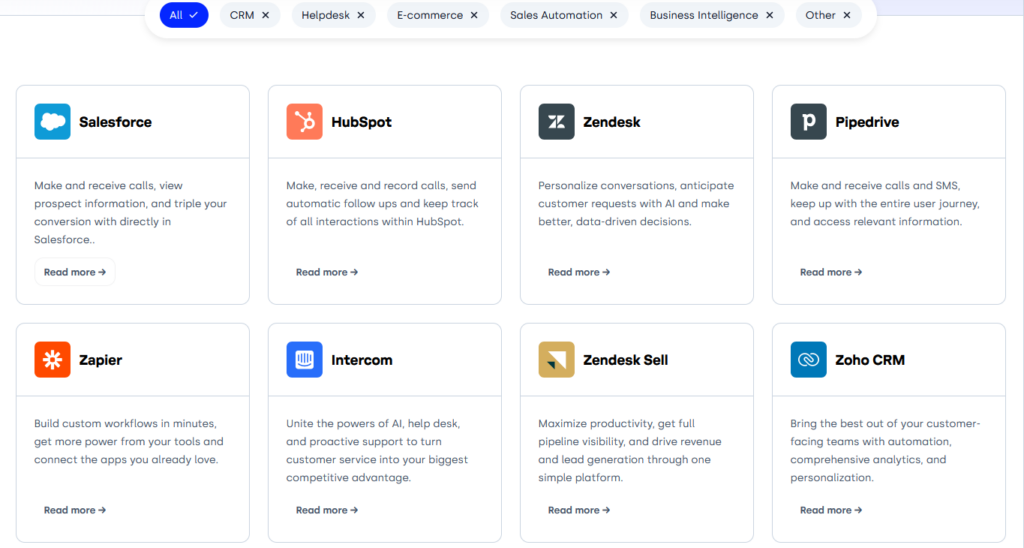From Silos to Synergy:
Omnichannel vs Multichannel Customer Service

Businesses with strong omnichannel strategies retain an average of 89% of their customers, compared to just 33% for those without*. This staggering gap shows how a seamless customer experience can make or break loyalty.
Think about a customer navigating from social media to email and effortlessly continuing the conversation. That’s the strength of omnichannel service—turning multiple touchpoints into a single cohesive journey.
But how does that differ from multichannel customer service, and which one fits your business best? Let’s dive in to explore the distinctions, their impact on customer satisfaction, and how to choose the right approach for your goals.
Key Takeaways:
- Multichannel systems offer flexibility and are straightforward to implement, though managing separate channels may introduce challenges in coordination.
- Omnichannel strategies aim to unify interactions, fostering seamless customer experiences and supporting stronger, trust-based relationships.
- Adopting the right approach requires aligning with your business goals, resources, and customer expectations—both strategies can thrive with the right tools.
- Adopting a unified approach to customer support can enhance scalability and help maintain high-quality customer interactions as your business grows.
What is Multichannel Support?
Multichannel customer service gives customers the freedom to reach out to companies across multiple platforms like email, phone, social media, and live chat. It’s sole focus is on letting the client pick the inbound channel they’re most comfortable with.
But here’s the catch: these channels often operate independently. Imagine emailing a support team about a refund, then calling the next day, only to hear, “We don’t have your email on file.” This disconnect between platforms can turn a simple issue into a headache.
While multichannel setups provide versatility, their lack of integration can leave customers feeling like they’re navigating a maze instead of getting quick solutions. When executed effectively, multichannel service can provide both choice and convenience for customers.
Try CloudTalk and experience the benefits for yourself
How Does Multichannel Customer Service Work?
In a multichannel call center, every channel, whether it’s email, phone, or social media, runs on its own track. Support teams manage them separately, often lacking the big-picture view of their customer journey. The result? More silos than synergy.
Here’s how it plays out:
- A customer emails about a billing question, then calls the next day for an update. Without integrated channels, the agent might ask for details again.
- Social media messages are handled by one team, while live chat inquiries go to another. This disjointed setup causes uneven response times and dropped conversations.
- SMS campaigns blast out offers, but without syncing to customer profiles, they feel generic.
- Customer Impact and Churn Repeated explanations and inconsistent service not only frustrate customers but also increase the likelihood of them turning to competitors.
When your channels don’t talk to each other, your team ends up playing detective, and your customers are left waiting. Multichannel systems are great for offering diverse touchpoints, but aligning them is key to avoiding frustration for both customers and agents.
What Is a Multichannel Call Center Solution?
Multichannel Customer Service: Pros and Cons
Pros:
- Offers customers multiple contact options. Customers can choose the channel that suits them best, like phone, email, or live chat.
- Easier to implement with existing systems. Adding separate channels often requires less setup and training.
- Allows focus on specific channels. Businesses can prioritize platforms based on customer preferences, like emphasizing social media for younger audiences.
- Cost-effective for SMBs. Multichannel systems are often affordable and scalable, making them a practical choice for smaller operations.
Cons:
- Channels operate in silos. Without integration, customers may have to repeat themselves, leading to frustration.
- Lack of unified customer data. Teams can’t see the full customer journey, making it harder to personalize support.
- Inconsistent messaging across platforms. Teams managing channels independently can lead to mixed signals for customers.
- Difficult to track customer journeys. A disconnected system means missing key insights about customer behavior.
What is Omnichannel Support?
Omnichannel customer service connects all your communication channels into one cohesive system, enabling businesses to gather customer feedback effectively and improve customer experiences across every touchpoint. It ensures every interaction feels like a natural continuation of the last, regardless of the platform.
Take the billing issue example from before: a customer begins on live chat and later follows up through email. With omnichannel service, there’s no need for them to repeat the details—support agents have access to the complete context, allowing them to pick up the thread effortlessly.
By integrating customer data across platforms, omnichannel service enhances efficiency while showing customers that their time and concerns truly matter.
How Does Omnichannel Customer Service Work?
Omnichannel systems unify your communication channels, ensuring every touchpoint works together to create a connected customer journey. Support teams no longer start from scratch with each interaction—they have full visibility into a customer’s history.
Here’s how omnichannel delivers standout experiences:
- A customer starts troubleshooting with an omnichannel chat widget and then escalates to a live agent over the phone without needing to repeat their issue.
- During a support ticket, an agent references the customer’s recent social media feedback, adding a personal touch.
- Marketing emails adapt in real time, tailoring messages based on browsing history or previous inquiries.
This approach doesn’t just resolve problems; it builds trust by valuing the customer’s time and preferences.
Find Out 7 Reasons to Choose Cloudtalk as your Omnichannel Contact Center Solution
Omnichannel Customer Support: Pros and Cons
Pros:
- Provides a seamless customer experience. Customers can move between channels effortlessly, avoiding repetitive explanations and enjoying smooth interactions.
- Centralized customer data enhances personalization. Agents have access to a full customer history, enabling tailored and context-aware support.
- Consistent messaging across all channels. Unified communication reinforces brand reliability and builds customer trust.
- Improves customer satisfaction and loyalty. Meeting high customer expectations fosters long-term relationships.
Cons:
- Higher implementation costs. Setting up advanced systems and integrations requires significant investment.
- Requires integration of various systems. Ensuring all platforms work cohesively can be technically challenging.
- More complex to manage. Coordinating operations across multiple integrated systems adds layers of oversight.
- Needs ongoing maintenance and updates. Regularly upgrading systems ensures performance but requires dedicated resources.
Comparing Omnichannel vs. Multichannel Customer Service
Choosing between omnichannel vs multichannel support isn’t just about features—it’s about the experience you want to create for your customers. Here’s how the two stack up:
Aspect
Multichannel
Omnichannel
Independent channels. Each platform operates separately.
Integrated channels. All platforms work as a unified system.
Versatile. Customers choose their preferred touchpoints.
Seamless. Conversations flow naturally across channels.
Data Management
Separate. Teams manage customer data within individual channels.
Unified. Agents access complete customer profiles.
Implementation Complexity
Simple. Lower technical requirements.
Advanced. Requires integrated workflows and tools.
How to Choose the Right Strategy for Your Business
Selecting the right customer service strategy depends on understanding your customers, aligning with your goals, and leveraging the right tools. Here’s how to approach it:
Understand Your Customers’ Expectations
Do your customers expect seamless transitions between channels, or are they comfortable with standalone interactions? Surveys and data from customer interactions can highlight their preferences. Tools like Call Monitoring help analyze live customer interactions, giving you insights into what your audience values most.

Assess Your Resources
Evaluate your technology stack and budget. While an omnichannel strategy often requires robust integration, multichannel solutions may be easier to implement with fewer resources. Use Analytics to monitor channel performance and allocate resources effectively.

Align with Your Business Goals
Your strategy should match your long-term objectives. Businesses focusing on customer loyalty and personalized experiences, need CRM integrations to allow their support teams to centralize customer data, and improve response times and interaction quality.
Understand the full impact of data fragmentation in our guide for Ops, IT, and Sales Managers

Take an Incremental Approach
Starting with multichannel service doesn’t mean you can’t create fluid customer interactions. IVR tools direct calls to the right agent or department, minimizing friction and making even multichannel experiences feel more connected and intuitive.

Monitor and Adapt
No strategy is perfect from the start—success comes from continuous improvement. Monitor metrics like recurring customer issues or response times to identify gaps in your service. Features like Topics Extraction provide valuable insights by analyzing customer conversations, helping you identify trends and refine your workflows.

Multichannel or Omnichannel? The Choice Is Clear
Your customer service strategy shapes how customers perceive and interact with your business. Multichannel systems provide a robust solution, enabling diverse communication channels and flexibility for growing businesses. On the other hand, omnichannel strategies focus on integration, offering seamless interactions across platforms.
The right approach depends on your goals—whether it’s leveraging simplicity and adaptability or unifying channels for a more cohesive customer experience. Both strategies can drive success when aligned with your business needs.
Ready to create seamless experiences customers will love?
Explore what phone calls of the future are like.
Sources
FAQs
What is an omnichannel approach?
Omnichannel integrates all communication channels into a unified system, ensuring seamless, personalized customer experiences.
Why is it important to have an omnichannel approach to customer service?
It enhances customer satisfaction by creating consistent, efficient interactions across platforms, boosting loyalty and operational efficiency.
Is omnichannel support suitable for small businesses?
Yes, small businesses can adopt omnichannel systems to build loyalty and streamline interactions, though scaling might require resources.
What industries benefit most from omnichannel support?
Retail, e-commerce, healthcare, and SaaS greatly benefit, offering tailored, efficient, and connected customer experiences.




















